This page has been archived and is being provided for reference purposes only. The page is no longer being updated, and therefore, links on the page may be invalid.
| January 2003 |
Yummy Raisins Developed by California TeamRaisins called Selma Pete and Diamond Muscat offer a taste treat for consumers and—in the case of Selma Pete—a labor-saving option for growers. The raisin grapes resulted from a decade of research by ARS' renowned grape-breeding team at the San Joaquin Valley Agricultural Sciences Center, Parlier, Calif. Selma Pete grapes will dry on the vine after the canes that bear the fruit have been cut to stop the flow of water to grape clusters. Dry-on-the-vine grapes can be mechanically harvested, thus lowering labor costs. 
Selma Pete and Diamond Muscat are ready to harvest earlier than some other grape varieties, meaning that they are unlikely to be caught in—and damaged by—rainstorms early in the fall. Selma Pete vines produce impressive quantities of seedless grapes that dry to form sweet, juicy raisins. Diamond Muscat is also a seedless grape. That's a major advantage over the well-known Muscat of Alexandria, which has to be mechanically deseeded, resulting in sticky, damaged raisins. The rich flavor of Diamond Muscat makes it ideal for confections such as chocolate-covered raisins or for dessert wines. Selma Pete and Diamond Muscat, first made available to growers and nurseries in 2001 and 2000, respectively, are descendants of parent vines developed in the early 1900s by USDA scientists in California and are the newest of the raisin grapes from the California laboratory. For more information, contact David W. Ramming, (559) 596-2790, USDA-ARS San Joaquin Valley Agricultural Sciences Center, Parlier, CA. Dark-Orange Carrots: Better Beta-Carotene Buy?Dark-orange carrots may deliver more beta-carotene to your system than their lighter orange counterparts. Beta-carotene imparts the attractive orange color to carrots and acts as an antioxidant—a type of compound thought to reduce risk of cardiovascular disease and certain kinds of cancer. Too, our bodies convert beta-carotene into vitamin A, a nutrient essential for good vision and proper growth of bones and teeth. 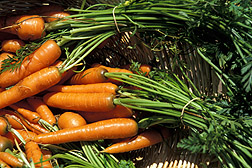
Preliminary results of a study by an ARS carrot breeder in Madison, Wis., and scientists at the University of Wisconsin, Madison, indicate that volunteers had higher levels of this phytonutrient in their blood during the time they breakfasted on muffins made from higher-carotene carrots than when they ate muffins baked with the lower-carotene ones. The volunteers for this 11-day study were healthy men and women in their 20s. Beta-carotene content of their meals was controlled, in order to help isolate the effect of the carrot-derived beta-carotene. Researchers next want to determine whether the greater intake of beta-carotene translates to a higher level of vitamin A; the body converts beta-carotene into the vitamin. ARS' carrot-breeding research has significantly boosted the beta-carotene content of commercially grown carrots. For further information, contact Philipp W. Simon, (608) 262-1248, USDA-ARS Vegetable Crops Research Unit, Madison, WI. Finding Folate: New Assay ReadiedA new method now being developed to detect folate in people and the foods they eat may help ensure that Americans are getting enough of this essential B vitamin. The nutrient is of special concern for mothers-to-be because low folate levels have been linked to increased risk of birth defects. 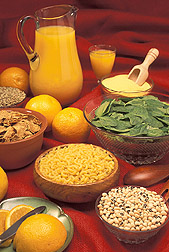
Folate helps the body form genetic material, or DNA. It is important to blood-cell makeup and reduces the risk of heart disease by thwarting the buildup of excess levels of an amino acid, homocysteine. The detection technique that researchers at the ARS Beltsville (Md.) Human Nutrition Research Center are refining employs two well-known procedures—high-performance liquid chromatography, or HPLC, and fluorescence. This approach should enable the user to detect levels of the various forms of folate, including folic acid—a synthetic folate used in many food products. The procedure should be as useful as—but less expensive than—the HPLC plus mass spectroscopy procedure, or HPLC-MS, that the Beltsville team developed earlier (2001, Analytical Biochemistry, vol. 298, no. 2, pp. 299-305). For more information, contact Robert J. Pawlosky, (301) 504-8071, USDA-ARS Beltsville Human Nutrition Research Center, Beltsville, MD. Exercise Helps Hispanic Diabetics Lower MedicationWeight lifting or similar exercise might help people with type 2 diabetes decrease their need for medication to control this disease. A recent study from the ARS Jean Mayer USDA Human Nutrition Research Center on Aging shows this for the first time. The 16-week study, described in the December 2002 issue of Diabetes Care (vol. 25, no. 12, pp. 2335-2341) involved 60 Hispanic men and women over age 55 who had an average nine-year history of type 2 diabetes. All volunteers had to pass a physical exam and take an electrocardiogram before being admitted to the study. Scientists focused on Hispanic Americans for this research because their incidence of diabetes is about twice that of non-Hispanic whites. Half of the volunteers did resistance training, such as weight lifting, three times a week for the entire study; the other study participants did not. The researchers found that 22 out of 31 exercisers were able to reduce their requirement for diabetes medication. Only 1 of the 31 non-exercisers was able to do that during the same time period. Further work is needed to determine the optimum intensity of an exercise program in which older adults with type 2 diabetes could safely achieve maximum results. For more information, contact Carmen Castaneda Sceppa, (617) 556-3081, ARS Jean Mayer USDA Human Nutrition Research Center on Aging at Tufts University, Boston, MA. Pear Bars: Orchard-Fresh Flavor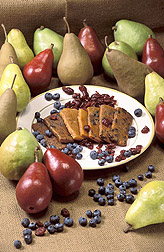
Pear bars, a new, all-fruit, all-natural treat from ARS scientists and pear growers in the Pacific Northwest, stay soft and chewy without the need for artificial preservatives. The delicious treats are about the size of a typical granola bar but a bit slimmer. HR Mtn. Sun, Inc., of Hood River, Ore., is working with ARS scientists to further test the shelf life of the bars, and plans to produce them using the procedures that the ARS researchers patented. The company intends to market an all-pear bar that has bits of dried pears in it, as well as a pear-blueberry and a pear-cranberry bar. Each pear bar contains about the same amount of nutrients—including vitamin C, iron, and potassium—as two fresh pears. For more information, contact Tara H. McHugh, (510) 559-5864, USDA-ARS Western Regional Research Center, Albany, CA. All That Pleases About Hispanic Cheeses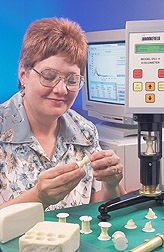
Whether made at home or at a restaurant, traditional Hispanic dishes usually don't taste authentic if made with American-style cheese. So ARS scientists at the Eastern Regional Research Center, Wyndmoor, Pa., are now helping U.S. cheesemakers meet the nation's growing demand for Hispanic cheese and to extend the shelf life of these tasty products. The researchers are scrutinizing the physical and chemical properties of the cheeses, relying not only on laboratory instruments, but also on the evaluations of a panel of taste testers. The goal: replicate, in new, pasteurized, Hispanic-style cheeses, the full flavors, varied textures, and cooking qualities of cheeses made outside of the United States. The scientists are focusing on four Mexican cheeses: Queso Blanco, Panela, Asadero, and Mennonite-style cheese. For more information, contact Diane Van Hekken, (215) 836-3777, USDA-ARS Eastern Regional Research Center, Wyndmoor, PA. Blueberries—A Brain Booster?New research with blueberries provides additional evidence that the fruit-–when fed to laboratory rats–-boosts brain power. Lab rats fed blueberry supplements equal to one cup daily in humans had an increased "birth rate" of brain cells in the region responsible for memory—the hippocampus—as compared to rats not fed the blueberry supplements. 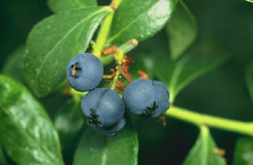
What's more, blueberry-supplemented rats did better in tests of their memory than did their counterparts. The research was conducted at the ARS Jean Mayer USDA Human Nutrition Research Center on Aging, Boston, Mass. Follow-up studies will investigate how natural compounds in blueberries interact with molecules needed for creating new cells in the hippocampus and other parts of the brain. For more information, contact James A. Joseph, (617) 556-3178, ARS Jean Mayer USDA Human Nutrition Research Center on Aging at Tufts University, Boston, MA. Calcium, Vitamin D Chop Seniors' Tooth LossAbout 33 percent of Americans aged 65 and older have no teeth. But a new study suggests that seniors may minimize tooth loss if they get their daily recommended dietary allowance of calcium (1,000 to 1,200 milligrams) and vitamin D (400 to 600 international units). Scientists at the ARS Jean Mayer USDA Human Nutrition Research Center on Aging, Boston, Mass., worked with colleagues at the Veterans Affairs Healthcare System and Boston University in this research. Volunteers for the study—145 healthy men and women over age 65—received either placebos or 500 milligrams of calcium and 700 international units of vitamin D as supplements for the first three years of the study. During the subsequent two years, volunteers didn't take the supplements. Only 13 percent of the volunteers who had taken the supplements lost one or more teeth during the first two years of the study as compared to 27 percent of the placebo group volunteers. Though follow-up investigations are needed to confirm these results, this preliminary study strongly suggests that nutrition education for seniors can improve their dental health. For more information, contact Elizabeth A. Krall, (617) 638-6216, ARS Jean Mayer USDA Human Nutrition Research Center on Aging at Tufts University, Boston, MA. Improved Baby Formula—A Bonus From Cotton ResearchThe first U.S.-approved infant formula to offer both DHA and ARA—two healthful, natural fatty acids—was made possible in part from ARS discoveries. 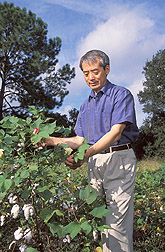
ARS researchers at the Southern Regional Research Center, New Orleans, La., helped scientists at Martek Biosciences Corp., Columbia, Md., overcome obstacles to gleaning DHA and ARA from oils in algae and fungi. They were helped by an ARS-developed technique for separating out, and purifying, oil from cotton seeds. The result? Enfamil Lipil baby formula from Mead Johnson Nutritionals, introduced in the United States in 2002, includes Martek's proprietary blend of DHA—short for docosahexaenoic acid—and ARA, or arachidonic acid. Before then, formulas approved for sale in the United States lacked DHA because the typical source of this nutrient—oil from coldwater fish—quickly becomes rancid and can impart an unwanted fishy flavor. A study, conducted elsewhere with funding from the National Institute of Child Health and Human Development, showed that babies fed formula supplemented with DHA and ARA performed better in mental and visual acuity tests than did babies fed formula without these nutrients Developmental Medicine and Child Neurology 2000, vol. 42, pp. 174-181. For more information, contact Peter J. Wan, (504) 286-4450, USDA-ARS Southern Regional Research Center, New Orleans, LA. Good News for Chocolate Lovers!Think candy bars don't grow on trees? The beans that yield chocolate, cocoa, and cocoa butter do. Now, nine superior Theobroma cacao trees have been selected by ARS scientists as top performers, after 10 years of testing. 
Material from the trees, suitable for grafting to rootstocks such as the commonly grown EET-400, are now being made available to researchers and growers by the staff of the ARS Tropical Agriculture Research Station, Mayaguez, Puerto Rico, where the cacao work was done. Scientists developed the promising new trees by hand-grafting scionwood onto EET-400 rootstock, an approach they say is better than relying on hybrid seed. The new selections, as they are known to horticulturists, produce higher yields than parent trees. That's important, because an estimated 30 to 40 percent of the world's cacao crop is lost each year to insect pests and fungal diseases. These natural enemies can include black pod, witches' broom, frosty pod rot, and the cocoa pod borer. For more information, contact Ricardo J. Goenaga, (787) 831-3435, USDA-ARS Tropical Agriculture Research Station, Mayaguez, PR. Calcium-Fortified Cereals Raise Kids' Calcium UptakeReady-to-eat breakfast cereals, fortified with a moderate amount of calcium, can significantly boost kids' calcium intake. That's according to a study with 27 children aged six to nine. 
Importantly, the extra calcium didn't interfere with the youngsters' ability to absorb another essential nutrient, iron. Sometimes increasing the amount of one nutrient can interfere with absorption of another. Adequate intake of calcium during childhood and adolescence is thought to help prevent onset of osteoporosis—a disease characterized by brittle bones—later in life. Scientists with the ARS Children's Nutrition Research Center at Baylor College of Medicine, Houston, Texas, conducted the study. Kids participating in the research ate either nonfortified cereal containing only 39 milligrams of calcium per ounce or fortified cereal that provided 156 milligrams of calcium per ounce. All of the children ate cereal at breakfast, with milk, and as an afternoon snack, without milk. The scientists reported the findings in the Journal of Pediatrics, 2001 (vol. 139, pp. 522-526). For more information, contact Steven A. Abrams, (713) 798-7164, USDA-ARS Children's Nutrition Research Center at Baylor College of Medicine, Houston, TX. At Your Fingertips: Nation's Best Nutrient Data
There's a new shortcut to healthy eating, thanks to research by scientists at the ARS Beltsville (Md.) Human Nutrition Research Center, and colleagues at HealtheTech, Inc., of Golden, Colo. Anyone who has a handheld PDA (personal digital assistant) that runs the Palm Operating System can now download the U.S. Department of Agriculture's National Nutrient Database for Standard Reference, Release 15. The database is the nation's leading source of information about the vitamins, minerals, and other nutrients in more than 6,000 food items. Users can select a food group from the database, choose a specific food within that group, then learn about the nutrient content of their selection. PDA access to the database makes it a handy reference at home, in the office, at a restaurant, or at the supermarket, for example. The free-of-charge download is available on the World Wide Web. The research collaboration yielded the software package that makes the download quick—about 30 seconds—and the database searchable from a hand-held PDA. For more information, contact Rena Cutrufelli, (301) 504-0693, USDA-ARS Beltsville Human Nutrition Research Center, Beltsville, MD. |
|
The United States Department of Agriculture (USDA) prohibits discrimination in all its programs and activities on the basis of race, color, national origin, gender, religion, age, disability, political beliefs, sexual orientation, and marital or family status. (Not all prohibited bases apply to all programs.) Persons with disabilities who require alternative means for communication of program information (Braille, large print, audiotape, etc.) should contact USDA's TARGET Center at 202-720-2600 (voice and TDD). To file a complaint of discrimination, write USDA, Director, Office of Civil Rights, Room 326-W, Whitten Building, 14th and Independence Ave., SW, Washington, DC 20250-9410 or call 202-720-5964 (voice or TDD). USDA is an equal opportunity provider and employer. |

